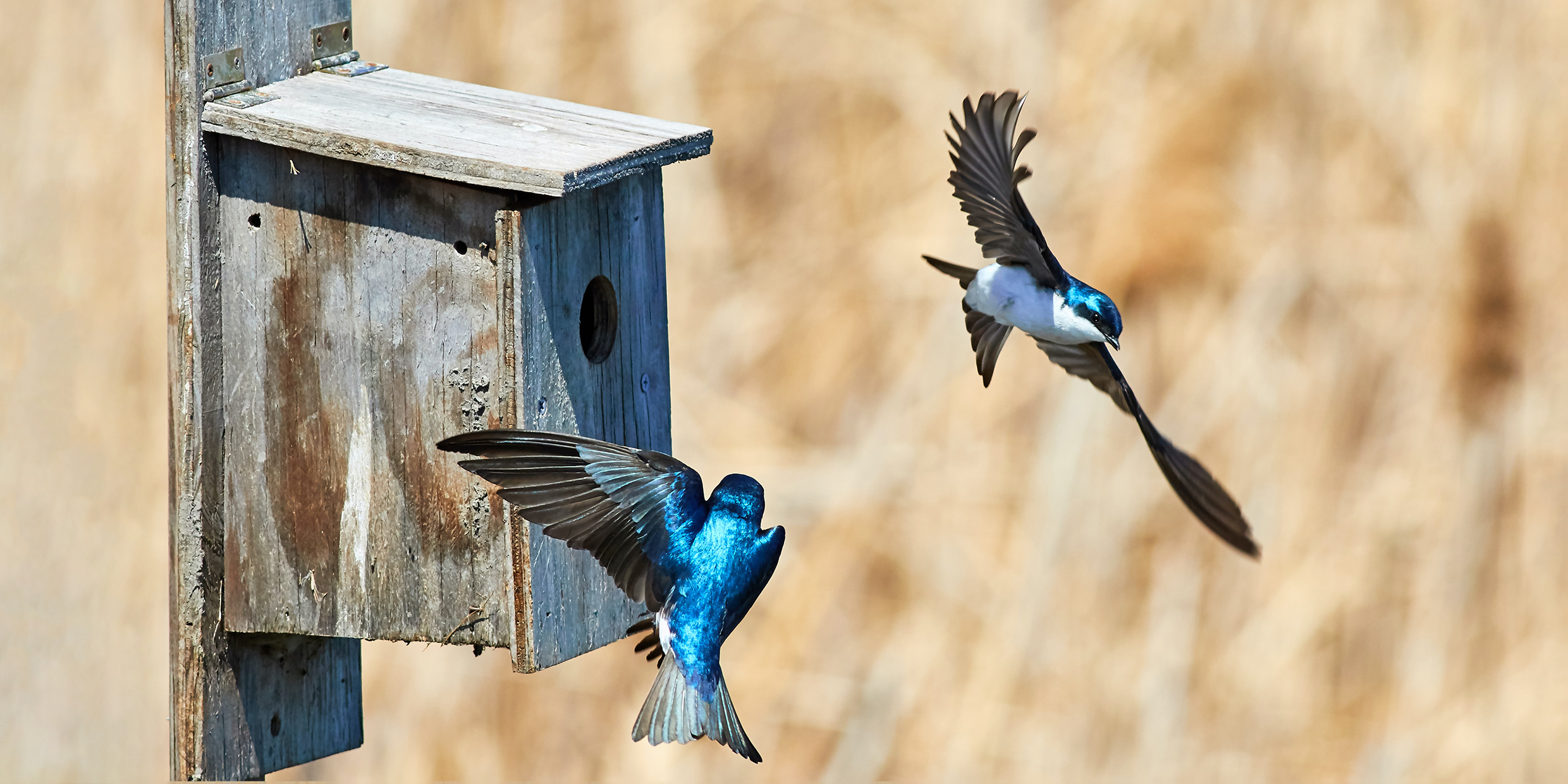Originally published 18 May 1992
For the past several weeks tree swallows have been nesting in bluebird boxes on conservation land nearby. The boxes weren’t meant for swallows, but — well, its spring and first come, first serve.
What beautiful birds! Shimmering blue-green backs. White bellies. Strike-out speed. They zip and stitch the morning meadow, quicker than the eye can follow.
Then, this past weekend, new boxes went up in the meadow. The next morning a pair of bluebirds was in residence, the essence of quiet domesticity. Male and female, they perched on the roof of their box and surveyed the world.
The tree swallows would not leave them alone. Diving and darting, the swallows harassed the bluebirds, sent them fluttering from their box, shattered their repose.
New metaphors came to mind. The swallows had backs of slick, metallic blue. They darted with zipgun speed. They flung themselves into the air like sky-smart, speed-crazed teenaged hoodlums looking for trouble. The hapless bluebirds were innocent victims.
Whats going on here? What is this compulsion to anthropomorphize the birds? Why cant I just let the swallows and the bluebirds be?
It’s an old habit, deeply ingrained in our race, to see ourselves in the animals. Aesop did it. Philosophers and theologians of the Middle Ages did it. Nineteenth century naturalists did it and the tradition carried right into our own century.
Here is American nature writer Neltje Blanchan describing the house wren, in a book that educated and entertained our grandparents: “If you fancy that Jenny Wren, who is patiently sitting on the little pinkish chocolate-spotted eggs in the center of her feather bed, is a demure, angelic creature, you have never seen her attack the sparrow, nearly twice her size, that dares put his impudent head inside her door. Oh, how she flies at him! How she chatters and scolds! What a plucky little shrew she is, after all!”
In another bird handbook from early in the 20th century, Mabel Osgood Wright describes the American crow as a “feathered Uriah Heap” and the jay as a “robber baron.” The bluebird is the “color-bearer of the spring brigade” and the song sparrow is “the bugler.”
My favorite bit of bird anthropomorphism is F. Schuyler Mathews’ description of the meadowlarks song as the first two bars of Alfredo’s aria in La Traviata, “sung with charming accuracy.” Mathews was another of the ornithologists who instructed our grandparents.
That’s all gone now. Anthropomorphic references in a nature handbook today would undermine the author’s authoritativeness and credibility. Styles have changed. We no longer see ourselves in the animals. The new fashion is to see the animals in ourselves.
Sociobiologists lead the way. They look to our affinity with other animals to explain not only our physical frame but also many of our moral and intellectual behaviors. Harvard’s E. O. Wilson, the father of sociobiology, has written that “the brain exists because it promotes the survival and multiplication of the genes that direct its assembly. The human mind is a device for survival and reproduction, and reason is just one of its various techniques.”
Thus we look into our brain stems for shadows of reptilian ancestors. We examine the ant hill for the origins of societies. We watch gorillas and chimps to discover the roots of human aggression and sexuality. Even our ethical systems and religions are part of our evolutionary heritage, say sociobiologists.
It is nor so much that the crow is a “feathered Uriah Heap” as that we are crows. It is not so much that jays are “robber barons” as that human robber barons share an evolutionary inheritance with jays. The telescope has been turned around and we look at animals through the other end of the instrument.
This inversion of viewpoint is one of the significant intellectual developments of our time. It has profound implications for sociology, psychology, and biology. It changes the way we think about environmentalism, ecology, and animal experimentation, perhaps even how we eat. Philosophers and theologians have yet to work out how it effects our sense of purpose and ultimate destiny.
Aesop and E. O. Wilson share a conviction that our common cause with animals is more than limbs, brains, gullets, and genitals. For Aesop — as for medieval natural historians — animals symbolize human virtues and vices. For Wilson — and modern scientific materialists — humans embody animal characteristics through the agency of genes and evolution. For most of us of the Disney generation, our imaginations are trapped somewhere between the two poles.
My anger at the swallows for apparently so needlessly tormenting the bluebirds, and the rush of anthropomorphic metaphors that came to mind, are indicative of my own split allegiances — a scientific materialist with one leg in the Aesopian ornithology of another era.



